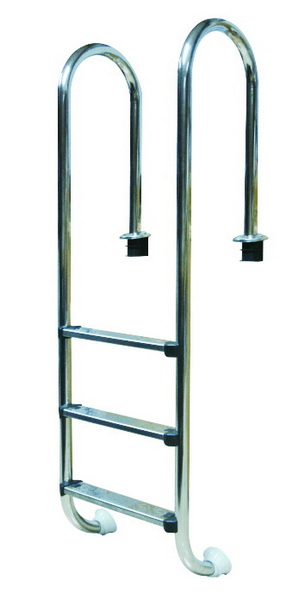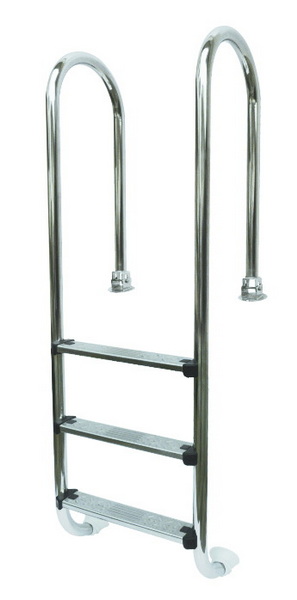







Content Menu
● What Causes Pool Ladder Issues?
● Quick Diagnosis: Assessing Ladder Problems
>> Fixing Loose Steps and Rails
>> Repairing Broken Ladder Steps
>> Dealing With Rust and Corrosion
>> Stabilizing and Reinstalling the Ladder
● Essential Tools and Materials
● How to Replace a Pool Ladder
● Maintenance Tips to Prevent Future Damage
>> 1. How do I know if my pool ladder is secure?
>> 2. What is the fastest way to stabilize a loose pool ladder?
>> 3. How often should I replace a pool ladder?
>> 4. Can I paint rusted pool ladders to prevent further corrosion?
>> 5. Why do pool ladder steps break so often?
Pool ladders are essential fixtures for safe and convenient pool access, but with frequent use and exposure to water, wear and tear is inevitable. Whether you manage a resort, a swim club, or represent foreign brands sourcing OEM pool equipment from premium Chinese suppliers, understanding how to fix a pool ladder can save you maintenance costs and extend the lifespan of your facilities. This guide covers practical solutions suitable for commercial technicians and individual pool owners alike for clarity and ease of use.[1][2][3]

Pool ladders can malfunction due to several factors, especially in commercial settings where they see heavy usage. Common causes include:
- Environmental wear and tear: Continuous exposure to chlorinated water, sunlight, and chemicals weakens ladder materials.[4]
- Loose nuts and bolts: Frequent use can loosen connections, making ladders unstable.[5]
- Broken steps or rails: Over time, plastic or resin steps may crack, while metal frames can bend or warp.
- Rust and corrosion: Metal ladders, particularly those not made from stainless steel, are prone to rusting in humid environments.[6][4]
- Improper installation: Incorrect assembly leads to instability and premature failure.
Early identification helps prevent accidents, making regular pool ladder inspections essential for both safety and compliance.
Before taking corrective action, perform a thorough pool ladder assessment using this simple troubleshooting checklist:
Visual Inspection
- Look for cracks, loose or missing screws, bent rails, faded resin, or corrosion spots on metals.[4]
Stability Test
- Shake the ladder gently from all directions; note any wobble, movement, or noise, which indicates loose fittings or anchors.[5]
Step Integrity
- Step firmly onto each rung to see if any flex or shift abnormally; soft or spongy steps may require replacement.[7][3]
Hardware Condition
- Inspect mounting brackets, nuts, and bolts for tightness and rust.
If any issue is detected, follow the appropriate repair guide below, referencing step-by-step images and videos as needed.
Before you begin repairs, safely remove the ladder from the pool:
1. Locate Ladder Anchors: Most pool ladders are secured by anchor cups embedded in decking.[8][3]
2. Loosen Bolts: Use a wrench (usually 1/2 inch or 9/16) to unscrew bolts, releasing wedges or fixing plates.[3][8]
3. Lift Ladder Out: Pull the ladder upward, keeping it vertical to avoid catching or scratching liners.
Ladders often become wobbly when bolts holding rails and steps loosen. To fix this:
1. Inspect Connection Points: Identify areas with loosened hardware, especially at joints with mounting brackets.[5][4]
2. Tighten Bolts & Screws: Use a power drill or wrench for a secure, snug fit. Avoid over-tightening nylon nuts to prevent thread damage.[1][5]
3. Sealant Application: Add silicone sealant at joints for waterproofing, then let dry for 48 hours before reinstalling.[5]
A cracked or broken step is a safety hazard. Replace using these steps:
1. Purchase Replacement Steps: Measure your ladder's rail width (commonly 18 inches) and order steps accordingly. Top OEM manufacturers in China offer universal-fit models.[10][3]
2. Remove Broken Step: Using a screwdriver or socket wrench, unscrew and slide out the damaged rung.[3]
3. Install New Step: Align with rail notches and secure with included hardware. Double-check step alignment before tightening.
4. Check Step Stability: Firmly apply pressure to ensure the new step is immovable.
Rust is a leading cause of ladder failure in commercial pool environments.
DIY Preventive and Repair Steps:
- Surface Cleaning: Remove surface rust using steel wool or abrasive pad.[6][4]
- Rust Treatment: Apply Rust-Oleum or similar anti-rust spray paint. Let dry fully before use.[6]
- Replace Severely Corroded Parts: If sections are structurally unsound, replace using OEM-rated ladders offering corrosion resistance.
Pool ladders must be made secure to prevent accidents. Here's how to stabilize them:
1. Leveling: Use a four-foot level to assure all contact points are evenly aligned.[5]
2. Securing Anchors: Fill each anchor hole with bolts or heavy-duty screws. Consider using upgraded stainless steel hardware for longevity.[5]
3. Extra Stability: Slide rigid foam pool noodles or foam backer rods under ladder legs; drape weighted sandbags over lower rungs if additional weight is needed.[5]
4. Concrete Anchoring: For deck ladders, anchor legs directly in concrete for maximal stability.

Prepare the following before starting:
- Screwdrivers (flat and Phillips head)
- Socket wrench set (1/2" and 9/16")
- Replacement bolts, nuts, mounting brackets, and steps
- Silicone sealant
- Steel wool and anti-rust spray
- Foam pool noodles/backer rods
- Weighted sandbags for stabilization
- Safety gloves and eye protection
Sometimes, repair isn't enough and complete replacement is necessary:
1. Remove Old Ladder: Follow safe removal process as above.[10][3]
2. Inspect Anchor Cups: If mounting anchors are also damaged, core drill out and install new anchor cups, ensuring correct alignment.[10]
3. Fit New Ladder: Insert into anchor cups; tighten bolts and check stability.[8][3]
4. Test for Safety: Climb and shake ladder gently to ensure solid installation.
- Always wear protective gloves when handling tools or rusted parts.
- Turn off pool circulation before disassembly.
- Lay ladder parts on towels or pool floats to avoid deck or liner damage.[3]
- Replace ladders showing severe corrosion, bent rails, or missing steps immediately.
- Avoid excessive weight additions that could strain mounting hardware.
Prevent recurring pool ladder failures through proactive maintenance:
- Weekly Inspection: Tighten all bolts and check for movement.
- Monthly Cleaning: Remove debris, stains, and scale using a magic eraser or diluted chlorine bleach.[13][4]
- Semiannual Rust Check: Inspect and touch up any exposed metal surfaces with rust-preventive spray.[6]
- Seasonal Storage: Thoroughly dry ladders before winter removal; store all hardware in labeled bags.[5]
- Order OEM Spare Parts: Source components directly from trusted Chinese manufacturers for exact fit and higher durability.
A well-maintained pool ladder ensures safety, convenience, and longevity for both commercial and residential pool environments. By following the step-by-step fix instructions, making smart use of visual aids and expert videos, and implementing ongoing care, foreign brands and wholesalers can reduce downtime and deliver higher customer satisfaction, all while benefitting from the premium OEM services offered by leading Chinese factories. Whether you need minor repairs or a complete replacement, thorough diagnostics and quality hardware are key to reliable pool ladder performance.[4][3][5]

Shake the ladder from side to side; enlist another person to observe movement, then climb up and down. Any looseness should be corrected immediately for safety.[5]
For a temporary fix, slide foam pool noodles under the base or drape sandbags over the bottom rungs. For long-term security, install new mounting brackets or bolts from the original manufacturer.[5]
Wood or metal ladders typically last four to five years; top resin ladders last up to ten. Replace any ladder with serious structural damage, excessive rust, or repeated instability that cannot be fixed by maintenance.[5]
Yes, remove surface rust with steel wool, then apply anti-rust spray paint (such as Rust-Oleum). Severely rusted ladders should be replaced.[6]
Plastic or resin steps degrade due to UV and chemical exposure. Heavier usage in commercial settings accelerates failures. Always source replacement steps from trusted OEM suppliers for enhanced durability.[3]
[1](https://www.youtube.com/watch?v=JJkG7vsan1E)
[2](https://www.youtube.com/watch?v=AcVIHFSLCTY)
[3](https://www.youtube.com/watch?v=z2tjyznDJek)
[4](https://georgiapoolcleaning.com/how-to-clean-and-maintain-pool-ladders-and-rails/)
[5](https://blog.watsons.com/blog/stabilize-above-ground-pool-ladder)
[6](https://www.reddit.com/r/pools/comments/1fmwm9l/how_to_repair_a_rusted_intex_pool_ladder/)
[7](https://www.poolkingfilter.com/news/Best-Way-To-Fix-Pool-Ladder-Steps.html)
[8](https://www.youtube.com/watch?v=kBZZrt8Gop4)
[9](https://www.freepik.com/free-photos-vectors/pool-ladder)
[10](https://www.reddit.com/r/swimmingpools/comments/8owlt8/need_advice_replacing_cut_out_pool_ladder/)
[11](https://www.tiktok.com/@lindsayrburnett/video/6977024788241943813)
[12](https://www.youtube.com/watch?v=Nb82H39bU0g)
[13](https://newcastleswimmingpools.com/swimming-pool-ladder-maintenance-tips/)
[14](https://www.facebook.com/groups/637529959937311/posts/2663144890709131/)
[15](https://www.facebook.com/groups/637529959937311/posts/2618402638516690/)
[16](https://www.tiktok.com/@sawdustengineer/video/7516647504822242602)
[17](https://www.facebook.com/groups/637529959937311/posts/2604021406621480/)
[18](https://www.poolkingfilter.com/how-to-fix-a-broken-pool-ladder.html)
[19](https://www.facebook.com/groups/637529959937311/posts/2656993104657643/)
[20](https://www.youtube.com/watch?v=zBLLAkx1d40)
